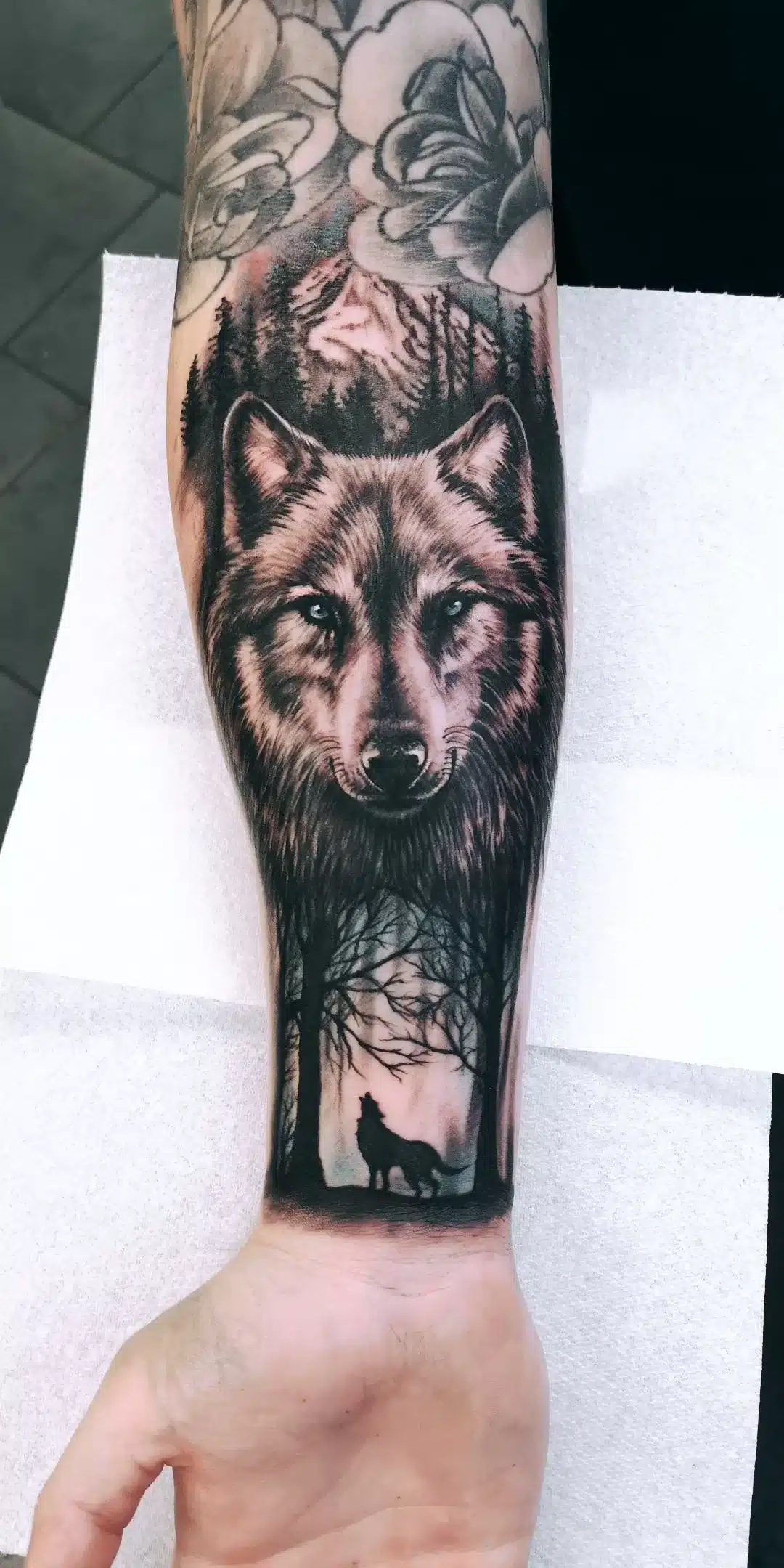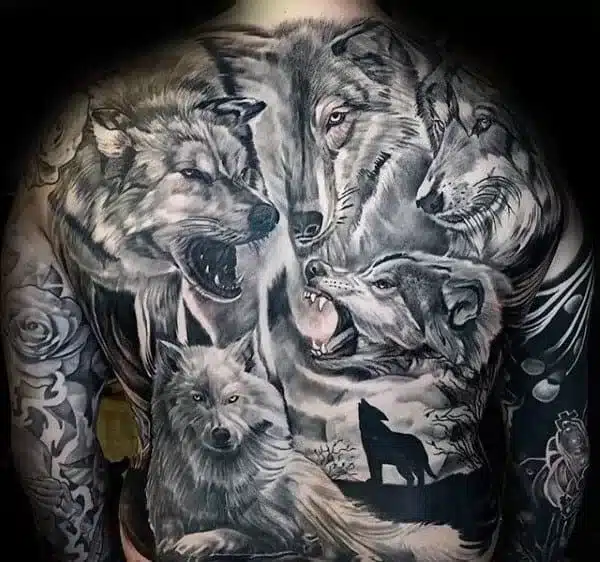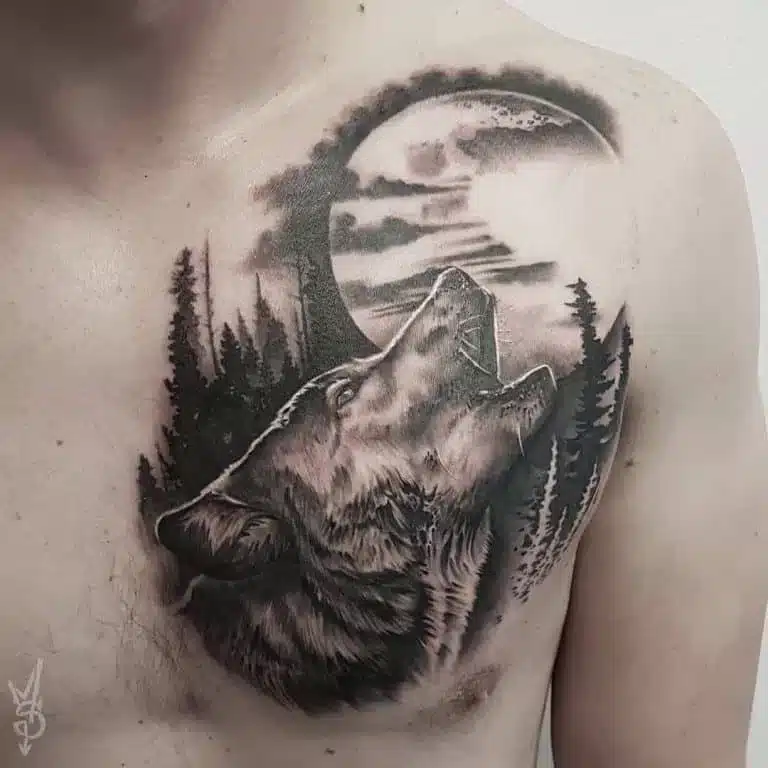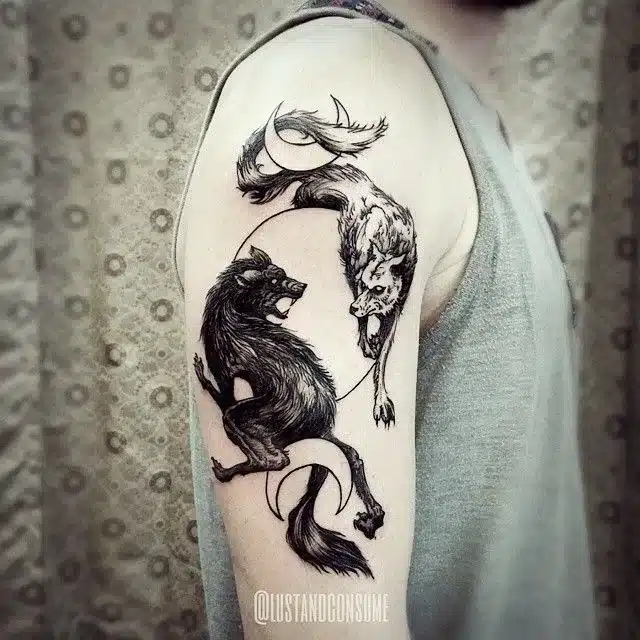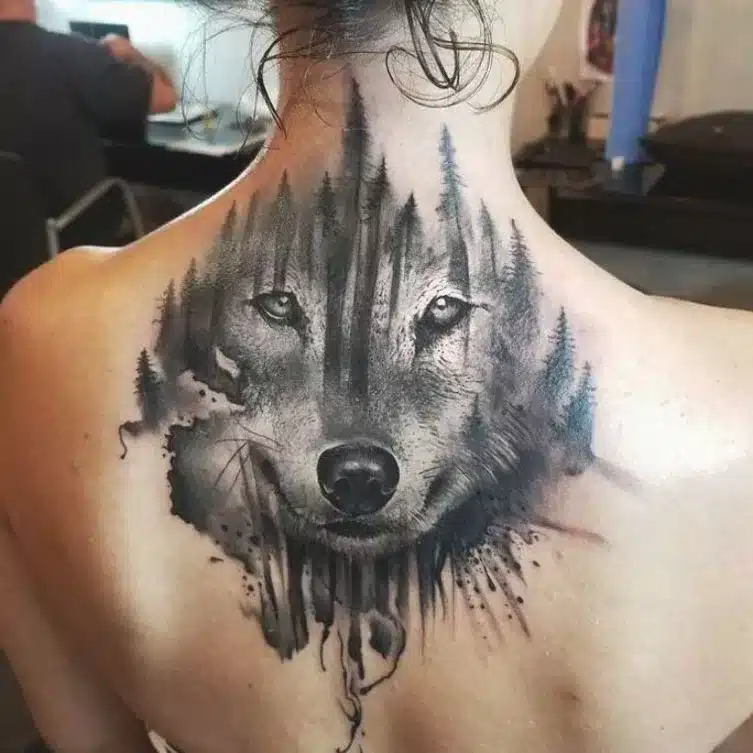The wolf has captivated the human imagination for centuries, embodying a variety of powerful meanings and representing a diverse array of cultural, spiritual, and personal values. From strength and loyalty to independence and transformation, wolf tattoos offer a unique canvas for self-expression and personal growth. Join us as we journey through a collection of stunning wolf tattoo designs, each accompanied by an exploration of the empowering messages they convey. Allow yourself to be inspired, and find the perfect wolf tattoo idea that resonates with your inner spirit and personal journey.
Are you only interested in tattoo designs and want to skip the educational part?
No problem, we got you covered! Click HERE to get inspired.
What do wolfs symbolize in different cultures?
Wolves have been a part of many cultures and mythologies around the world, and their symbolic meanings can vary widely depending on the cultural context. Here are some examples of what wolves symbolize in different cultures:
Native American cultures: Many Native American tribes view the wolf as a powerful and revered animal. They are often seen as symbols of courage, loyalty, and wisdom, and are sometimes regarded as spiritual guides or protectors. The wolf is also associated with the moon and the hunt.
Norse mythology: In Norse mythology, wolves are associated with Odin, the god of war and wisdom. Two wolves named Geri and Freki are said to accompany Odin on his journeys, and a giant wolf named Fenrir is destined to fight against the gods during Ragnarok, the end of the world.
Chinese culture: In China, the wolf is associated with the lunar calendar and is often depicted in art and literature. They are seen as symbols of loyalty and are sometimes regarded as protectors of children.
Celtic culture: In Celtic mythology, the wolf is often associated with the warrior spirit and is seen as a symbol of the hunt. They are also regarded as protectors of the natural world and are sometimes associated with the goddess Cerridwen.
Roman culture: In ancient Rome, the wolf was revered as a symbol of power and strength. The story of Romulus and Remus, who were said to have been raised by a she-wolf, is a famous legend that highlights the wolf's importance in Roman mythology.
These are just a few examples of how wolves have been symbolized in different cultures throughout history. It's worth noting that the meaning of the wolf can vary depending on the specific culture and context.
What Does a Wolf Tattoo Symbolize?
A wolf tattoo can symbolize various meanings depending on the individual, the design, and cultural context. Some common interpretations include:
Strength and power: Wolves are known for their physical strength, hunting prowess, and ability to survive in harsh environments. A wolf tattoo can represent personal strength, resilience, and determination.
Loyalty and family: Wolves are social animals that live in packs and are known for their strong bonds and loyalty to their family members. A wolf tattoo can symbolize the importance of family, loyalty, and protection of loved ones.
Independence and freedom: Although wolves are pack animals, they can also symbolize a strong sense of independence and the desire for personal freedom.
Spirituality and connection to nature: In many indigenous cultures, wolves hold significant spiritual meaning and are often associated with powerful spirits or gods. A wolf tattoo can represent a deep connection to nature and the spiritual world.
Transformation and personal growth: Wolves often appear in myths and folklore as shapeshifters or as symbols of transformation. A wolf tattoo might symbolize personal growth, change, and the ability to adapt to new situations.
Balance and duality: The idea of balance and duality can be symbolized by a wolf tattoo, as wolves are often associated with both light and dark aspects of nature, life, and spirituality.
Remember that the symbolism of a wolf tattoo can vary greatly from person to person, and the meaning ultimately depends on the individual's personal beliefs, values, and experiences.
Best Wolf Tattoo Ideas and Their Meanings
If you're considering getting a wolf tattoo, look no further. Here are five of the most popular wolf tattoo ideas and their meanings.
The Lone Wolf Tattoo
This tattoo design represents an individual who can stand alone and is independent as well as strong-willed, resilient, and resistant to change. It also symbolizes one's ability to survive despite any odds or hardships. The lone wolf is usually depicted with its head held high, boldly facing whatever challenges come its way.
Pack Wolf Tattoo
This type of tattoo design showcases a group of wolves working together in perfect harmony and cooperation towards a common goal or purpose, instead of individualism, like with the lone wolf tattoo. It symbolizes strength in numbers and how much more powerful we become when we work together towards something greater than ourselves.
Wolf Howling at the Moon Tattoo
This tattoo design is commonly seen on people who want to honor their ancestors or family members that have passed away, as it symbolizes remembrance and tribute for those that have been lost but not forgotten. It also stands for living life to its fullest without fear or regret and having faith that even when things seem dark or hopeless, there's always light at the end of the tunnel if you keep pushing forward no matter what comes your way.
Wolves Fighting Tattoo
This type of tattoo design typically represents inner conflicts within oneself, such as self-doubts or struggles with personal goals; however, it could also mean rivalries between two people or groups that are struggling against each other for power and control over something else (such as land).
Wolf Head Tattoo
A simpler version of some other wolf-related tattoos, this type typically means strength, power, courage, and wisdom all rolled into one; it can also represent one's protective nature over loved ones or family members since wolves are known to be loyal companions who fiercely guard their packs against danger at all costs.
The History of Wolf Tattoos
Tattoos of wolves have been around for centuries. In fact, evidence of wolf tattoos can be found in cultures all around the world.
In Native American culture, wolves were often seen as symbols of strength and power. They were also believed to be protectors of the tribe.
In Egyptian mythology, the god Anubis was depicted as having a head like a wolf's. Similarly, the Greek goddess Artemis had two wolves accompanying her as she hunted in the woods.
Vikings believed that Odin had two wolves, Geri and Freki, who would accompany him on his travels. In Chinese culture, meanwhile, wolves were seen as symbols of loyalty and fidelity.
These myths show us that wolves have been seen as powerful companions to gods and goddesses for centuries in many ancient cultures.
The ancient Romans associated wolves with Mars—the god of war—and believed they were direct descendants of this deity. Similarly, the Celts saw them as representations of wisdom and guidance during adversity. Even today, wolves are seen as symbols of family bonds and unity among those who wear them in tattoo form.
In Native American culture, the wolf was an important spiritual figure representing strength and courage during times of hardship or danger. As such, it was not uncommon for warriors to adorn their bodies with wolf tattoos to honor this powerful creature and its formidable spirit.
These tattoos usually depicted a single wolf howling at the moon or running wild across a prairie landscape. They were accompanied by symbols like feathers or dreamcatchers—items commonly associated with Native American spirituality.
Today's pop culture has embraced wolves in much the same way that our ancestors did centuries ago; they remain symbols of strength and resilience even when faced with overwhelming odds or adversity. This is evident in movies like The Grey (2011), which follows a group of survivors stranded in Alaska after their plane crashes into an icy wilderness inhabited by dangerous predators—including hungry wolves!
Similarly, books like Twilight (2008) feature shape-shifting werewolves who struggle against natural and supernatural forces while defending those they love most fiercely against all odds. This type of imagery continues to make its way into modern tattoo designs, which often take on a more abstract or realistic aesthetic than traditional Native American tattoos did before them.
Wolf Tattoo placements and their pain level
Different areas of the body feel more or less painful when getting a tattoo, and depending on your pain tolerance, you may consider different locations for your wolf tattoo. Let's look at some popular areas for wolf tattoos and the pain level associated with each.
Upper Arm/Shoulder Area: The upper arm/shoulder area is one of the most popular places to get a wolf tattoo. This is because it's relatively easy to conceal if needed and has plenty of room for a larger design. It is also not too painful; many people describe it as feeling like a scratchy sensation or mild discomfort. The only potential downside is that this area fades quicker than other locations due to its visibility and constant movement throughout the day.
Chest/Ribs Area: The chest or rib area is another popular choice for a wolf tattoo. This location allows you to feature prominent parts of your design while still being able to conceal them depending on your clothing choices. As far as pain goes, this area can be quite sensitive so expect more than just mild discomfort. It's often described as feeling like hot needles into the skin, which can be uncomfortable for some people but bearable nonetheless.
Lower Back: A great spot for a more intimate design, lower back tattoos are becoming increasingly popular these days due in part to their ability to be concealed when desired but still made visible with certain outfits or swimsuits. When it comes to pain levels, this location tends to feel like an intense pressure sensation that many people find manageable with proper breathing techniques and breaks during long sessions.
@yuelong_official wolf tattoo art vedio @gabrielsouza.tattoo #yuelong #yuelongtattoo #yuelongofficial #wolftattoo #tattoos #animaltattoo #emalla #pepax ♬ original sound - YUELONG OFFICIAL
General Breakdown Of Tattoo Pain Levels On Different Body Parts
Here is a breakdown of the different tattoo pain levels:
- Low: This level of pain is generally described as a mild discomfort or tickling sensation. It is similar to the sensation of getting a light scratch or scrape.
- Moderate: This level of pain is generally described as a moderate discomfort or aching sensation. It is similar to the sensation of getting a deep scratch or scrape or being pinched.
- High: This level of pain is generally described as a strong discomfort or throbbing sensation. It is similar to the sensation of getting a burn or being stung by a bee.
It's important to note that pain tolerance is highly individual and can vary greatly from person to person. Some people may find certain body parts more or less painful than others, and the same body part can be more or less painful for different people. Additionally, the level of pain can be affected by factors such as the size and location of the tattoo, the skill of the tattoo artist, and the individual's own pain threshold.
Tattoo placement pain level chart
Body Part | Pain Level | Explanation |
Forehead | Low | The forehead has few nerve endings, so it is not a particularly painful area. |
Eyebrows | Low | The eyebrows have few nerve endings, so the pain level is relatively low. |
Ear | Low | The ear is a relatively thin and fleshy area, so the pain level is low. |
Nostril | Low | The nostril is a small area with thin skin, so the pain level is low. |
Lip | Low to Moderate | The lip has more nerve endings than some other areas, so it may be slightly more painful. |
Cheek | Low to Moderate | The cheek has a moderate amount of nerve endings, so it may be slightly more painful. |
Moderate | The Neck has a moderate amount of nerve endings, so it may be slightly more painful. | |
Chest | Moderate to High | The chest has a high concentration of nerve endings, so it can be quite painful. |
Abdomen | High | The abdomen has a high concentration of nerve endings, so it can be quite painful. |
Back | High | The back has a high concentration of nerve endings, so it can be quite painful. |
Shoulders | High | The shoulders have a high concentration of nerve endings, so they can be quite painful. |
Upper Arms | Moderate to High | The upper arms have a moderate to high concentration of nerve endings, so they can be somewhat painful. |
Elbows | High | The elbows have a high concentration of nerve endings, so they can be quite painful. |
Forearms | Moderate | The forearms have a moderate concentration of nerve endings, so they are not as painful as some other areas. |
Hands | High | The hands have a high concentration of nerve endings, so they can be quite painful. |
Lower Arms | Low to Moderate | The lower arms have a lower concentration of nerve endings, so they are not as painful as some other areas. |
Wrists | Low | The wrists have a low concentration of nerve endings, so they are not very painful. |
Lower Back | High | The lower back has a high concentration of nerve endings, so it can be quite painful. |
Buttocks | High | The buttocks have a high concentration of nerve endings, so they can be quite painful. |
Thighs | High | The thighs have a high concentration of nerve endings, so they can be quite painful. |
Knees | High | The knees have a high concentration of nerve endings, so they can be quite painful. |
Calves | Low to Moderate | The calves have a low to moderate concentration of nerve endings, so they are not as painful as some other areas. |
Ankles | Low | The ankles have a low concentration of nerve endings, so they are not very painful. |
Tattoo aftercare tips
Before getting a tattoo:
Choose a reputable tattoo artist and parlor. Research the artist's portfolio and read reviews from previous clients.
Consult with the artist about the design and placement of the tattoo.
Make sure you are in good health. If you have any medical conditions or are taking any medications that may affect your ability to heal, be sure to let your tattoo artist know.
Consider using a numbing cream to reduce pain during the tattooing process. These creams contain a numbing agent (such as lidocaine) that can be applied to the skin before the tattoo is done. It's important to follow the instructions on the numbing cream and to only use it as directed.
Avoid alcohol, caffeine, and other substances that can thin your blood for at least 24 hours before getting a tattoo.
Eat a healthy meal before your tattoo session to ensure that your blood sugar is stable.
Wear loose, comfortable clothing that allows easy access to the area being tattooed.
After getting a tattoo:
Follow the aftercare instructions provided by your tattoo artist. These may include:
Keeping the tattoo clean and covered with a bandage for the first few hours after getting tattooed.
Washing the tattoo with lukewarm water and a mild soap (such as unscented, antimicrobial soap) and patting it dry with a clean towel.
Applying a thin layer of tattoo ointment or lotion (such as A&D or Aquaphor) to the tattoo and covering it with a clean bandage or wrap.
Repeating this process for the first few days, or until the tattoo has fully scabbed over.
Avoid soaking the tattoo in water for the first week, such as in a bath or pool.
Avoid picking or scratching at the scabs, as this can cause the tattoo to fade or become infected.
Avoid exposure to direct sunlight or tanning beds for at least 2-4 weeks.
If you experience any redness, swelling, or unusual discharge, contact your tattoo artist or a healthcare professional.
Overall, it's important to keep your tattoo clean and moisturized during the healing process to ensure that it heals properly and looks its best. Using a numbing cream can help reduce pain during the tattooing process, but it's important to use it as directed and to follow all aftercare instructions to ensure that your tattoo heals properly.
People Also Ask:
How Much Does It Cost?
The cost of your wolf tattoo will depend on several factors, including the size and complexity of the design, the artist's experience level, and how long it takes to complete the piece. In general, however, you can expect to pay anywhere from $100 for a small black-and-white design to over $1,000 for an elaborate full-color portrait.
How Long Does It Take?
Again, this depends on the size and complexity of your chosen design as well as the skill level of your artist. A small black-and-white design may take just an hour or two, whereas an intricate full-color portrait could take several hours or even multiple sessions. Discuss this with your artist beforehand so you can plan accordingly.
Is A Wolf Tattoo Painful?
Getting a tattoo can be painful, but everyone has different pain tolerance levels, so it really depends on the individual. Some areas of the body are more sensitive than others; for example, tattoos on bony areas such as elbows and ankles tend to be more uncomfortable than those in fleshier spots like arms and legs. Your artist will likely use numbing cream or ointment to ensure you are as comfortable as possible while they work on your piece.
What Do Wolf Tattoos Mean?
Wolf tattoos can represent a variety of meanings depending on the wearer. They are often associated with protection, loyalty, strength, tenacity, and a connection to nature or our spiritual selves. Due to their wild and untamed nature, some people also view wolves as symbols of freedom and independence.
What Are The Best Colors For A Wolf Tattoo?
The best colors for a wolf tattoo depend on your style and preferences. Traditional black-and-white designs look classic and timeless, while vibrant pops of color can help bring your piece to life. Some popular colors for wolf tattoos include blues, purples, greens, and oranges. You can also choose to have your design in a combination of black-and-white and colors to create an interesting contrast.
What Are Some Common Designs?
Common designs for wolf tattoos include howling wolves, wolves in packs or packs of wolves, wolf eyes, and realistic or abstract portraits. For a unique look, you can also include other elements, such as mountains, trees, stars, or moons. Your artist will be able to help you create the perfect design for your tattoo that reflects your personal style.
How do I choose the right wolf tattoo design for me?
To choose the right wolf tattoo design, consider your personal style, the meaning you want your tattoo to convey, and the placement on your body. Research various designs and styles, and consult with your tattoo artist to create a piece that resonates with you and complements your unique personality.
Can I combine a wolf tattoo with other elements or symbols?
Absolutely! Combining a wolf tattoo with other elements or symbols can create a more personalized and meaningful piece. Popular choices include nature elements (trees, mountains, moon, stars), tribal patterns, or other spiritual symbols. Discuss your ideas with your tattoo artist to create a design that suits your vision.
How do I find the right tattoo artist for my wolf tattoo?
To find the right tattoo artist for your wolf tattoo, research local artists or studios with portfolios showcasing their work. Look for artists who specialize in the style you want, whether it's realism, traditional, or tribal. Read reviews, ask for recommendations, and consult with potential artists to discuss your ideas and ensure they can bring your vision to life.
How do I take care of my new wolf tattoo?
Proper aftercare is essential for a new tattoo to heal well and maintain its appearance. Your tattoo artist will provide you with detailed aftercare instructions, which typically include keeping the tattoo clean and moisturized, avoiding direct sunlight and submerging in water, and refraining from picking at scabs or peeling skin. Follow these guidelines to ensure your wolf tattoo heals well and looks its best.
Can I have a wolf tattoo if I have sensitive skin or allergies?
If you have sensitive skin or allergies, discuss your concerns with your tattoo artist before getting a wolf tattoo. They may recommend a patch test to determine if you have a reaction to the ink or provide alternative ink options designed for sensitive skin. It's important to communicate your concerns with your artist to ensure your safety and comfort during the tattoo process.
Watch A Video Of A Wolf Tattoo Done By A Pro:
250+ Wolf Tattoo Ideas To Get Inspired From
Final thoughts
Getting a wolf tattoo is an exciting and meaningful way to express yourself. Before starting the process, discuss your design ideas with your artist so they can help bring your vision to life. Also, remember that tattoos require proper care and upkeep to ensure they look great for years to come. Your wolf tattoo will make a lasting impression with the right preparation and maintenance.

